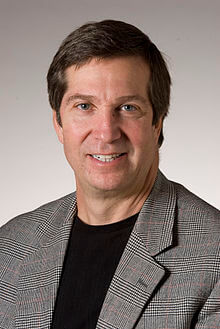 Jon Entine is an American science writer. He is the founder and executive director of the Genetic Literacy Project, a nonprofit that educates the public about the revolution in biomedicine and agricultural biotechnology. He was formerly a fellow at the Institute for Food and Agricultural Literacy at the University of California, Davis, the Center for Health & Risk Communication at George Mason University, and at the American Enterprise Institute. After working as a network news writer, producer and head of documentaries for NBC News and ABC News from 1974-1994, Entine moved into scholarly research and print journalism.
Jon Entine is an American science writer. He is the founder and executive director of the Genetic Literacy Project, a nonprofit that educates the public about the revolution in biomedicine and agricultural biotechnology. He was formerly a fellow at the Institute for Food and Agricultural Literacy at the University of California, Davis, the Center for Health & Risk Communication at George Mason University, and at the American Enterprise Institute. After working as a network news writer, producer and head of documentaries for NBC News and ABC News from 1974-1994, Entine moved into scholarly research and print journalism.
Entine has written seven books, four on genetics and chemical risk, and has addressed a range of controversial issues, including the genetics of sports; the shared ancestry of Jews, Christians and Muslims; socially responsible investing; and why organic farming will not scale to produce sustainable food. He is a contributing columnist and writer for dozens of newspapers and magazines. He has was won 19 major journalism awards including two Emmys, three CINE, Ohio State Award, Chris Award, Best Feature Film Interntional Sport Film Festival, and a National Press Club Award for Consumer Journalism.
Grégoire Canlorbe: You carefully investigated the genetic underpinnings of the over-representation of blacks in many high profile sports. Could you remind us of the fruits of your inquiry? Why do whites dominate strength related positions and events in so many sports—and why are blacks so poorly represented in some major sports, such as swimming?
Jon Entine: I think it’s phenomenal, really startling that if you look at the major sports around the world: track and field, football in Europe, American football, baseball, and basketball, which is an international sport, you see a very odd distribution of which athletes do the best in various sports. In many of the sports, the ones that require speed, quick reaction time, things like global and American football or basketball or sprinting, it’s utter dominance by athletes of West African ancestry.
In long distance running, which requires endurance, you see the dominance of East Africans and a few North Africans, whose ancestors evolved in higher altitudes, shaping their physique and physiology. You look at strength events, and you see dominance of East Europeans and Euro-Asians with very minimal representation of those of African ancestry. These aren’t just recent aberrations.
These patterns have persisted for decades and have actually become more pronounced as the playing field got more level, so ‘natural talent’ could emerge and environmental factors were at a minimum. Once the influence of performance enhancement drugs during the 1960s, 70s, and ‘89s driven by Russia and the Eastern bloc dissipated, which distorted who were the best athletes, we saw these patterns become even more pronounced around the world. And I think the more you research this, the more you understand that at the elite level of athletic competition, we are very much a product of our genetics and the patterns reflect evolution in different geographical areas.
This is not a black/white issue or an issue of ‘race’ as we have traditionally used the term. It’s about regions of evolutionary origin. Phenotypes and genotypes are shaped by thousands of years of evolution. Although some characteristics seem to loosely correlated with traditional, folkloric notions of race, many do not. Just look at the difference in body types and athletic skill sets of distance running East Africans and elite athletes who trace their primary descent to West Africa. The differences in physiology and physique may be small in the case of some characteristics, and there is a great deal of overlap, but those differences are magnified at the elite level of sports competition where a fraction of a second can make the difference between winning a gold medal or being an also ran.
Social factors alone or even significantly cannot explain why the top two thousand all time 100 meter times are held by a person of West African ancestry yet West Africans are almost nonexistent at the elite level of medium and long distance running. I addressed many of these issues, along with the toxic history of ‘race science,’ in my book Taboo: Why Black Athletes Dominate Sports and Why We’re Afraid to Talk About It. Although the book is now 20 years old, and some data are dated, the arguments in the book are now mainstream science and genetics. It was actually based on a documentary that I wrote and produced back in 1989 with Tom Brokaw, Black Athletes: Fact and Fiction.
The idea that anybody can grow up and become an elite athlete with the proper training and opportunities is just not supported by what we know of genetics. Genetics is not destiny, but I would say that genetics is like designing a house. You can tidy up the rooms a little bit, you can move things around, but generally speaking, who you are is like the house itself. Once it’s built, it’s set, and these predeterminations are the result tens of thousands of years of evolution.
That said, there are always cultural and genetic factors in play. There is a biocultural feedback loop in sports in which culture helps magnify small but meaningful biologically-based differences. People say, “Oh, there are few blacks in ice hockey,” for instance. Well, ice hockey is played in northern climates, and there have been relatively few blacks in Canada or in Europe, historically. So, the number of blacks is almost representative of the number of blacks in those regions. And some sports, like gymnastics, for instance, or swimming, require a lot of training. They require facilities, pools that are very expensive. Social opportunity has largely excluded minorities. The more factors that cost a lot of money, like the availability of expensive facilities, then, cultural and social factors come into play.
The sports that I cited: running, football, soccer, and basketball which are usually state sponsored or sponsored by schools—sports like those represent a level playing field. It doesn’t require special financial advantages to be a great long-distance runner or sprinter. It’s really natural talent that comes to the fore. So, it’s best to think of sports as a biocultural phenomenon—sports success. And the lower the cultural barriers to entry, the more genetic factors come into play. And those genetic based differences are not distributed equally among populations. In running, blacks of West African ancestry dominate the sprints, totally. In long distance running, blacks of East African ancestry dominate. And that’s purely a result of our genetic history.
Grégoire Canlorbe: It has been hypothesized that race differences in intelligence and in psychopathy should be connected to the severity of encountered winters over tens of thousands of years of evolutionary time—with Caucasians and a fortiori Northeast Asians having faced the coldest winters and consequently evolved the higher IQs and the lower psychopathy levels necessary to navigate difficult environmental circumstances. Do you endorse this alleged connection?
Jon Entine: Well, there has been some speculation on that controversial issue by evolutionary psychologists and others, as well as some geneticists, that some people embrace and some people do not. One of the suppositions is that evolution does shape who we are physically, and there are group differences–overlapping but real. We know that. And so, some people have asked, if genetics shape us physically, and we see the examples in sports, it must shape us psychologically and intellectually, as well. And there’s belief among many scientists that there are patterns of differences based at IQ tests—although many people like to dismiss them as unimportant or pseudo-science or racist. I think there’s profound evidence and belief within the psychometric community that IQ tests are very real measurements of a kind of intelligence. But how much of the differences are the result of evolutionary factors versus environmental and cultural factors, including those that impact biology, such as natal and childhood development. Obviously environmental factors predominant in explaining patterns of differences.
[Read more…] about A conversation with Jon Entine, for European Scientist
